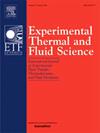海水条件下风力发电机叶片结冰分布及粘着特性试验研究
IF 3.3
2区 工程技术
Q2 ENGINEERING, MECHANICAL
Experimental Thermal and Fluid Science
Pub Date : 2025-07-29
DOI:10.1016/j.expthermflusci.2025.111575
引用次数: 0
摘要
由于高纬度沿海地区寒冷潮湿的环境,风力涡轮机叶片结冰会降低输出功率,并带来运行风险。尽管对海上风电机组结冰的研究越来越多,但这一领域的研究相对较少。通过结冰风洞试验和冰附着测量,研究了淡水和盐水(1 g/L)条件下温度对玻璃钢叶片表面冰分布和粘附强度的影响。结果表明:在−4℃时,叶片下表面通过水倒流效应形成冰柱,而盐水明显抑制冰柱的生长;随着温度的降低,冰型从釉状冰转变为混合冰,然后是霜状冰,冰的轮廓从不规则形状演变为准空气动力学形状。盐水冰的表面比淡水冰光滑,但在- 16℃时差异减小。冰的黏附强度随温度的降低而增加,但增长速度减慢。在相同温度下,淡水冰的粘附强度是盐水冰的2.5 - 4.7倍。这些发现为沿海风力涡轮机叶片结冰研究提供了重要的见解。本文章由计算机程序翻译,如有差异,请以英文原文为准。
An experimental study on icing distribution and adhesion characteristics of wind turbine blades in saltwater Condition
Icing on wind turbine blades reduces output power and poses operational risks due to cold, humid environments in high-latitude coastal regions. Despite increasing studies on offshore wind turbine icing, research in this field remains relatively scarce. This study investigates the temperature effects on ice distribution and adhesion strength of glass fiber-reinforced plastic (GFRP) blade surfaces under freshwater and saltwater (1 g/L) conditions through icing wind tunnel tests and ice adhesion measurements. Results show that at −4 ℃, the blade’s lower surface forms icicles through water runback effects, while saltwater significantly suppresses icicle growth. Decreasing temperatures induce ice-type transitions from glaze to mixed and then rime ice, with the ice profile evolving from irregular to quasi-aerodynamic shapes. Saltwater ice exhibits smoother surfaces than freshwater ice, but differences diminish at −16 ℃. Ice adhesion strength increases with decreasing temperature but shows decelerating growth rates. Freshwater ice demonstrates 2.5–––4.7 times higher adhesion strength than saltwater ice at equivalent temperatures. These findings provide critical insights into the icing research of coastal wind turbine blades.
求助全文
通过发布文献求助,成功后即可免费获取论文全文。
去求助
来源期刊

Experimental Thermal and Fluid Science
工程技术-工程:机械
CiteScore
6.70
自引率
3.10%
发文量
159
审稿时长
34 days
期刊介绍:
Experimental Thermal and Fluid Science provides a forum for research emphasizing experimental work that enhances fundamental understanding of heat transfer, thermodynamics, and fluid mechanics. In addition to the principal areas of research, the journal covers research results in related fields, including combined heat and mass transfer, flows with phase transition, micro- and nano-scale systems, multiphase flow, combustion, radiative transfer, porous media, cryogenics, turbulence, and novel experimental techniques.
 求助内容:
求助内容: 应助结果提醒方式:
应助结果提醒方式:


